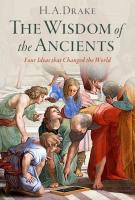
OUP (2025) h/b 153pp £24 (978101977773740)
D. is Research Professor Emeritus of History at University of California, Santa Barbara. The main focus of his active career related to the later Roman empire and particularly to Constantine and the adoption of Christianity as a state religion. What might a successful scholar in the twilight of his academic career do about the weight of information, insights and theories gathered during his studies but not yet properly shared with his contemporaries? Why not sit down and set out some of it in writing, particularly for a group of readers whom he might not have reached before?
That is what D. has done here, selecting four topics which he believes were important both when they were being developed in the ancient world and for the insights that they offer for us today. They are: monotheism; the recognition that on occasion the rights of an individual trump the rights of the state; the ability of the state to extend the rights and privileges which it grants to whomever it wishes; and the power of the brand which was Roma. His familiarity with his themes is such that it was probably possible for him to sketch his first draft without consulting any source, which is one of the reasons why this is such a happy, clear and fluid book to read.
On monotheism he muses on why some versions took off (Judaism and Christianity) but that of Akenhaten failed; why any monotheist belief system, being much more intellectually difficult and sociologically challenging than a polytheistic system, gained ground at all. Indeed, he suggests that the Hebrews at the outset did not fully understand what their system implied and had to helped there by the prophets.
On the rights of an individual over those of the state he ranges from the war lords of the Iliad, through the development of the poleis (where he suggests that a new norm was enhanced by the particular need for co-operation when fighting in a phalanx) to the complexities of the conflict between natural law and state law as argued by Socrates or by Sophocles in Antigone.
On the extension of rights, he suggests that the Romans were more generous than the Greeks because they needed more citizens initially to man their poleis (Sabine Women, etc.), subsequently Italy beyond Rome, and ultimately their empire. As to the Roma brand, he admires and explains its ability to flourish for so many centuries even when the original source of the brand had long lost its lustre and to be recognised as a brand even in Constantinople. He possibly gives too little attention to the competing brand (Athens/Greek) which may have been the more important influence when the two brands were rediscovered by the Muslims and the age of Enlightenment.
One of the difficulties in writing a book like this is to establish what the academic hinterland of your readership is likely to be. D. assumes that his readers will not be aware of or remember in detail the structure of the Cleisthenic demes, nor Plato’s allegory of the Cave, nor the plot of Antigone and will therefore need concise summaries of each, but he probably does expect that they will have read at least a chapter or two of Gibbon’s Decline and Fall. Each chapter is followed by a short reading list which tries hard not to drag the reader too far back into the academic thicket but probably fails. There are also about 25 black and white illustrations and 6 rather more useful maps.
All in all, this a charming book—ideal bedside fare for the general reader. It is full of information and challenging ideas, moves briskly and logically without any jargon in sight. Perhaps the author has four additional potent ideas in his sights.
Roger Barnes
